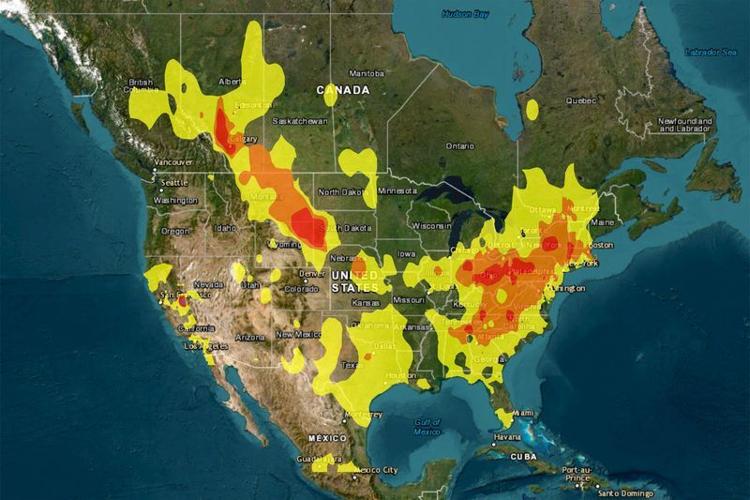ROME/BEIJING, (Reuters) – Italy put 23 cities on red alert as temperatures could reach 46 Celsius (114 Fahrenheit) today, one of the global hotspots as a wave of extreme heat, wildfires and flooding wreak havoc from the United States to China.
An intensifying heatwave has hit southern Europe during the peak summer tourist season, breaking records including in Rome and bringing warnings about an increased risk of deaths and heart attacks.
Wildfires burned for a third day west of the Greek capital Athens, with air water bombers resuming operations at first light and firefighters working throughout the night to keep flames away from coastal refineries.
Fanned by erratic winds, the fires have gutted dozens of homes, prompted hundreds of people to flee and blanketed the area in thick smoke. Temperatures could climb to 43C on Thursday, forecasters said.
In China, which this week was hosting U.S. climate envoy John Kerry for talks, tourists defied the heat to visit a giant thermometer showing surface temperatures of 80C.
In Beijing, which set a new record as temperatures remained above 35C for the 28th day in a row, Kerry expressed hope that cooperation to combat global warming could redefine troubled ties between the two superpowers.
A global pattern of heatwaves that have scorched parts of Europe, Asia and the United States this week have thrown that challenge into sharp relief.
Temperatures remained high across much of Italy on Wednesday, with 45-46C expected on the Mediterranean island of Sardinia and some inland areas of Sicily likely to see temperatures in the mid-40s.
The health ministry said it would active an information hotline and teams of mobile health workers visited the elderly in Rome.
“These people are afraid they won’t make it, they are afraid they can’t go out,” said Claudio Consoli, a doctor and director of a health unit.
Joggers took to the streets of the capital early in the morning in an effort to beat the heat.
While the heatwave appears to be subsiding in Spain, residents in Greece were left surveying the wreckage of their homes after the wildfires.
“Everything burned, everything. I will throw it all, it’s all waste. The boiler burned, it’s done, it melted,” said Abbram Paroutsidis, 65.
Spain warned of the risk of wildfires in most of the country though residents were allowed to return to their homes in La Palma island where a blaze that raged for five days was stabilised in one sector, although it remained active elsewhere.
Scientists have long warned that climate change, caused by greenhouse gas emissions mainly from burning fossil fuels, will make heatwaves more frequent, severe and deadly. They say governments need to drastically reduce emissions to prevent climate catastrophe.
In Germany, the heatwave sparked an unlikely discussion on whether workplaces should introduce siestas for workers.
In Spain, El Corte Inglés, one of the country’s largest department store chains, said sales of air conditioning units had jumped, as had interest in cooling pads for pets and horses.
EXTREME HEAT, FLOODS IN ASIA
In South Korea, heavy rain has pummelled central and southern regions since last week. Fourteen deaths occurred in an underpass in the city of Cheongju, where more than a dozen vehicles were swamped on Saturday when a river levee collapsed. In the southeastern province of North Gyeongsang, 22 people died, many from landslides and swirling torrents.
In India, flash floods, landslides and accidents related to heavy rainfall have killed more than 100 people in the north of the country since the onset of the monsoon season on June 1, where rainfall is 41% above average.
The Yamuna river reached the compound walls of the Taj Mahal in Agra for the first time in 45 years, also submerging several other historical monuments and gardens surrounding the 17th century, white-marble mausoleum. The same river flooded parts of the Indian capital including roads surrounding the historic Red Fort and Rajghat – a memorial to Mahatma Gandhi.
The Brahmaputra river, which runs through India’s Assam state, also burst its banks this month, engulfing almost half of the Kaziranga National Park – home to the rare one-horned rhino – in waist deep water, prompting animals to flee to roads and human settlements in search of safe ground.
In China’s western Xinjiang province, tourists with broad-brimmed hats and umbrellas braved scorching temperatures to take selfies by a giant thermometer that displayed a real-time surface temperature of 80C (176 Fahrenheit).
Each summer, people flock to the Flaming Mountains on the northern rim of Xinjiang’s Turpan Depression to see their corrugated slopes of brown-red sandstone and to take in the super-charged heat emanating from the ground.
In recent days, temperatures in Xinjiang and other parts of Asia, as well as Europe and the United States have shattered records.
On Sunday, a remote township in the Turpan Depression registered a maximum air temperature of 52.2C, smashing China’s national record of 50.3C set in 2015, also in the basin.
These unprecedented temperatures have added new urgency for nations around the globe to tackle climate change. With the world’s two biggest economies at odds over issues ranging from trade to Taiwan, Kerry told Chinese Vice-President Han Zheng on Wednesday that climate change must be handled separately to broader diplomatic problems.
“It is a universal threat to everybody on the planet and requires the largest nations in the world, the largest economies in the world, the largest emitters in the world, to come together in order to do work not just for ourselves, but for all mankind,” Kerry told Han.










